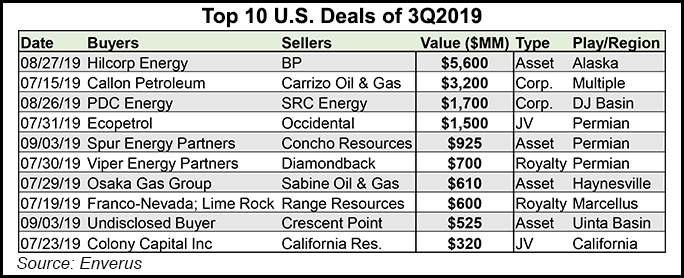Eagle Ford Shale | NGI All News Access | Permian Basin
E&P Buyers Looking Beyond Permian for Merger, Acquisition Opportunities
Dealmaking for U.S. exploration and production (E&P) companies extended beyond the Permian Basin during the third quarter, with the Top 10 transactions surpassing $17 billion, according to Enverus.

The Austin, TX-based oil and gas analytics company in its summary of domestic merger and acquisition (M&A) activity said the gains in the quarter came despite the reduction in spending by domestic E&Ps. Year-to-date transactions now exceed $85 billion.
“Most public E&Ps are highly limited in access to external capital right now,” said Enverus’ Andrew Ditmar, senior M&A analyst. “Shale companies are turning to deals as another option in the toolbox to bridge the gap to free cash flow and hopefully shift market sentiment back in their favor.”
Unlike recent years, when Permian deals dominated, “we are seeing broad geographic diversity in the current market and a variety of deal types including joint ventures and royalties.”
Hilcorp Energy Inc.’s purchase in August of BP plc’s legacy Alaska assets for $5.6 billion topped the list of M&A for the quarter.
Since exiting the Eagle Ford Shale, the privately held operator “has been a countercyclical buyer of conventional assets,” Enverus noted. “Meanwhile BP, a pioneer and major player in Alaska, is exiting to refocus U.S. operations on shale assets purchased from BHP.”
The next two largest third quarter transactions were a pair of corporate mergers.
Early in the quarter, Callon Petroleum Co. purchased Permian and Eagle Ford producer Carrizo Oil & Gas Inc. for $3.2 billion in an all equity/debt transaction.
However, whether the deal is completed is a question, as the takeover has run into some Callon investor opposition spearheaded by hedge fund Paulson & Co., which has cited the deal premium of 25%, and the addition of Eagle Ford assets to Callon’s pure-play Permian portfolio, as points of contention.
Meanwhile, PDC Energy Inc. announced it would buy fellow Denver-Julesburg (DJ) Basin producer SRC Energy Inc. in a “zero premium stock/debt deal for $1.7 billion. In a rarity for E&P deals in this market, both companies’ stock value moved up on the announcement as investors applauded the price and commitment to core DJ Basin operations,” according to Enverus.
“There is a broad consensus that corporate consolidation is positive for the industry,” Dittmar said. “While the benefits are there, getting the right deal in place is challenging. Companies that match up on asset fit are needed, as well as a low premium to avoid a buyer selloff. Conversely, targets have to be convinced of the long-term upside since an immediate payoff isn’t evident.”
Beyond corporate-level deals, public companies did not bring much to the table.
“Private capital has partially stepped up,” according to Everus, pointing to the most significant deal, KKR-sponsored Spur Energy Partners LLC, which has deployed more than $1 billion, including a $925 million acquisition from Concho Resources Inc. targeting the New Mexico Shelf within the Permian.
“Private equity looks to be largely sticking to their script from prior quarters and cautiously deploying capital on deals secured with significant cash flow,” Enverus market research director John Spears said. “There are ample opportunities.”
In one deal already announced for the fourth quarter, Warburg Pincus LLC affiliate Citizen Energy Operating LLC on Tuesday said it would take Oklahoma-focused producer Roan Resources Inc. private in a cash-and-debt-deal worth around $1 billion.
“We could see other small cap E&Ps with high debt and low share prices take similar buyout offers,” Spears said.
Some public independents may seek all-stock acquisitions like Callon and PDC did in the quarter, but cash offers may be needed from the private market or the largest public companies, which still have substantial internally generated funds and high, investment grade credit ratings, Enverus noted.
Low company and asset prices in the United States also are beginning to draw interest from abroad. Japanese liquefied natural gas importer Osaka Gas Co. Ltd. in July agreed to purchase Haynesville Shale operator Sabine Oil & Gas Corp. for reportedly $610 million.
A few days later, Colombia-based Ecopetrol SA signed a $1.5 billion joint venture (JV) deal with Occidental Petroleum Corp. targeting undeveloped acreage in the Permian Midland sub-basin. “While the Osaka deal was more narrowly tailored to source gas for LNG, the Ecopetrol JV shows that international companies view U.S. shale assets as competitive on a global basis,” said Enverus. “On a dollar-per-acre basis, the deal looks to have priced relatively in line with past Permian deal activity.”
A handful of voluntary Chapter 11 bankruptcy filings by Lower 48 producers also occurred in the third quarter, including by Halcon Resources Corp., Sanchez Energy Corp. and Alta Mesa Resources Inc.
“Thus far, the majority of Chapter 11 filings have ended in a recapitalization with creditors taking control of the company, but there could be a shift to more liquidations via bankruptcy sales processes as some lose patience and see companies going through multiple reorganizations,” according to Enverus.
In the final three months of this year, public E&Ps are likely to remain “highly focused” on keeping capital expenditures (capex) in check while maintaining moderate production growth to deliver free cash flow as promised, said the firm.
“Investors will likely closely watch as 2020 capex guidance is rolled out to look for any inflation. Current company valuations show a strong investor preference for E&Ps with clean balance sheets and established capital returns from dividends or buybacks versus high growth. That may translate to little appetite for making acquisitions among most independent public E&Ps.”
© 2024 Natural Gas Intelligence. All rights reserved.
ISSN © 2577-9877 | ISSN © 2158-8023 |
